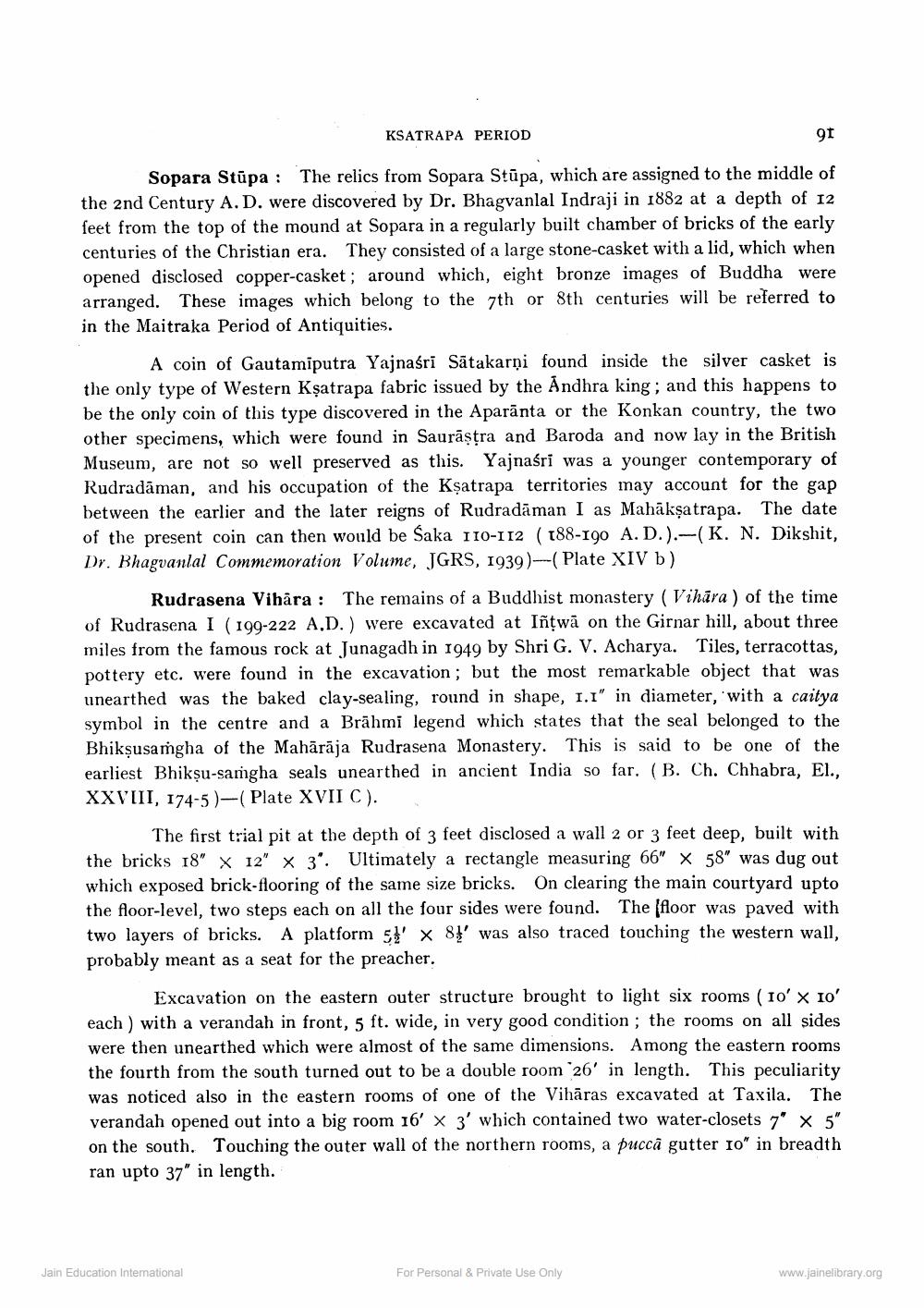________________
KSATRAPA PERIOD
gt
Sopara Stūpa : The relics from Sopara Stūpa, which are assigned to the middle of the 2nd Century A. D. were discovered by Dr. Bhagvanlal Indraji in 1882 at a depth of 12 feet from the top of the mound at Sopara in a regularly built chamber of bricks of the early centuries of the Christian era. They consisted of a large stone-casket with a lid, which when opened disclosed copper-casket; around which, eight bronze images of Buddha were arranged. These images which belong to the 7th or 8th centuries will be referred to in the Maitraka Period of Antiquities.
A coin of Gautamiputra Yajnaśri Sātakarņi found inside the silver casket is the only type of Western Kşatrapa fabric issued by the Andhra king; and this happens to be the only coin of this type discovered in the Aparānta or the Konkan country, the two other specimens, which were found in Saurāstra and Baroda and now lay in the British Museum, are not so well preserved as this. Yajnaśri was a younger contemporary of Rudradāman, and his occupation of the Kșatrapa territories may account for the gap between the earlier and the later reigns of Rudradāman I as Mahākṣatrapa. The date of the present coin can then would be Saka 110-112 (188-190 A.D.).-(K. N. Dikshit, Dr. Bhagvanlal Commemoration Volume, JGRS, 1939)--( Plate XIV b)
Rudrasena Vihāra : The remains of a Buddhist monastery (Vihāra) of the time of Rudrasena I (199-222 A.D.) were excavated at Iñtwā on the Girnar hill, about three miles from the famous rock at Junagadh in 1949 by Shri G. V. Acharya. Tiles, terracottas, pottery etc. were found in the excavation; but the most remarkable object that was unearthed was the baked clay-sealing, round in shape, 1.1" in diameter, 'with a caitya symbol in the centre and a Brāhmi legend which states that the seal belonged to the Bhikṣusamgha of the Mahārāja Rudrasena Monastery. This is said to be one of the earliest Bhiksu-samgha seals unearthed in ancient India so far. (B. Ch. Chhabra, El., XXVIII, 174-5)-( Plate XVIIC).
The first trial pit at the depth of 3 feet disclosed a wall 2 or 3 feet deep, built with the bricks 18" X 12" x 3". Ultimately a rectangle measuring 66" X 58" was dug out which exposed brick-flooring of the same size bricks. On clearing the main courtyard upto the floor-level, two steps each on all the four sides were found. The (floor was paved with two layers of bricks. A platform 51' x 81' was also traced touching the western wall, probably meant as a seat for the preacher.
Excavation on the eastern outer structure brought to light six rooms (10' X 10' each ) with a verandah in front, 5 ft. wide, in very good condition; the rooms on all sides were then unearthed which were almost of the same dimensions. Among the eastern rooms the fourth from the south turned out to be a double room 26' in length. This peculiarity was noticed also in the eastern rooms of one of the Vihāras excavated at Taxila. The verandah opened out into a big room 16' X 3' which contained two water-closets 7" x 5" on the south, Touching the outer wall of the northern rooms, a puccâ gutter 10" in breadth ran upto 37" in length.
Jain Education Interational
For Personal & Private Use Only
www.jainelibrary.org




